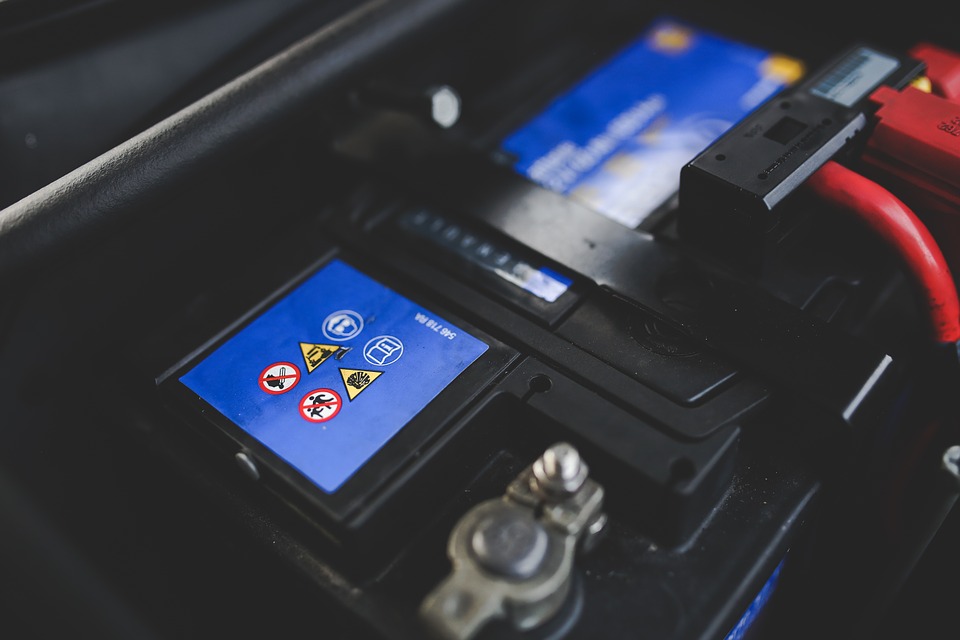Need help? We're here!
(888) 312-8812 Login SignupCommercial Vehicle Battery Testing & Maintenance: A Beginner’s Guide
August 12, 2021

Image Source: Pixabay
All too often, we only think about our vehicle’s batteries when it’s time to change them. But regular checkups and preventative maintenance can go a long way in extending battery life and ensuring the various devices and systems in your rig are always powered up and ready to go. So regardless of whether you’re a mechanic, operator, or fleet manager, knowing the proper servicing procedures for batteries and knowing what warning signs to look out for can help reduce downtime and prevent problems down the road. Many operators also keep in mind practical steps for keeping a truck roadworthy to maintain uptime throughout the year.
Battery Types
There are different types of batteries used in commercial vehicles, with each having its own maintenance requirements and features:
Flooded-cell. The oldest battery type in use in commercial vehicles today, flooded-cell lead-acid batteries are still popular because they offer more amp capacity per pound and per dollar. However, these batteries also require the most maintenance, including periodic replenishment of the cells with distilled water via removable caps. The cover and posts must also be regularly cleaned of grime and corrosion buildup. More recent, “maintenance-free” versions of flooded-cell batteries have their caps completely sealed and do not require additional water.
Absorbed glass mat (AGM). Unlike flooded-cell batteries that use liquid electrolytes, AGM batteries contain special fiberglass mats that absorb electrolytes. Its liquid-free design makes it easier to maintain, recharges faster, and eliminates the risk of leaks if the case is punctured or cracked. Their downside is that they tend to be heavier compared to flooded-cell batteries of similar power capacity.
Lithium-ion.
As its name implies, this battery type uses lithium ions as electrolytes and recharge energy. This allows the battery to store as much as 100% more energy per cycle than comparable lead-acid batteries. It’s also lighter, requires very minimal maintenance, and will hold its charge for as long as six months. However, it is also among the most expensive batteries in the market. Issues with improper care or charging can also contribute to symptoms similar to those seen when troubleshooting hard-starting issues in heavy-duty trucks.
Load Testing
It should be standard practice for any fleet for each battery to be load tested as part of the vehicle’s periodic maintenance checklist. Doing so will allow the technician to compare for consistency in performance and detect any reduction or other potential problems before it leads to a no-start condition on the road. And for fleets monitoring electrical reliability, it’s common to address charging or connection concerns alongside broader electrical system troubleshooting during scheduled inspections.
Thankfully, battery load testing isn't that complicated, as testing methods are similar regardless of battery type. Whether it is an old carbon pile load tester or the latest digital model with custom settings for lead-acid and lithium-ion batteries, the resulting data will provide a trained technician the information he needs to make an accurate diagnosis and take necessary action.
Best Practices
While regular load testing remains the best way to check up on the health of the battery, there are several other ways for commercial vehicle operators to ensure their proper health and continuous operation.
- Ideally, you should have the battery voltage checked at least once a month. A fully charged lead-acid battery should have a voltage of around 12.7 volts. If the voltage is at 12.5 volts, the battery is considered half-charged and is completely flat or dead at 12.0 volts.
- Engine startups can take a huge chunk of power from the battery, but the energy consumed is usually recharged during the trip. But if the vehicle is only traveling a short distance, the battery may not be able to regain the amount of power lost. If repeated multiple times in a day, the battery voltage will gradually diminish to the point that it can no longer start the engine. Also, if the battery is severely discharged, it can put significant strain on the starter motor and cause it to overheat. If your vehicle is mainly used for quick, short-distance trips, consider investing in a battery charger. The charger will ensure the battery is always at the correct voltage regardless of the distance or frequency in which the vehicle was used. Practices like these complement other smart habits aimed at avoiding costly truck repairs before issues escalate.
- Always use the right type of battery charger. One common service mistake is using the wrong charging method for the battery type. Old linear chargers, for example, that apply charge voltages greater than 15 volts are not recommended on modern maintenance-free or sealed batteries as this can lead to overcharging and possible loss of electrolytes. Modern “smart” battery chargers circumvent this by adjusting the charging voltage and amperage according to the condition of the battery. Also, make sure to use the charger in a ventilated area and away from flammable materials.
- Always keep the top of the battery clean and dry. Dirt, mud, and grime can serve as a conduit for the energy stored inside the battery to discharge, creating a short that can potentially kill the battery. Battery terminals also tend to corrode over time, especially in humid areas, but this can be mitigated by keeping the terminals clean and free of residue. Use an old toothbrush dipped in baking soda and water to scrub the terminals and rinse with cold water. Make sure that the engine is off and the cables disconnected before attempting to clean the battery to avoid injury.
- The rattling sound caused by a loose battery can be more than just a nuisance; excessive vibration can also damage the battery box or even the battery’s internal components (which can potentially lead to short circuits). So the battery must be held down properly with the correct battery clamp. As a rule of thumb, the nuts should be tightened until you feel a resistance and continue for an additional half turn. Do not tighten the bolts too much, as this can damage the threads or the battery case itself.
- Heat isn’t good for batteries as it increases the rate of water evaporation inside the cells, particularly in lead-acid types. And once cold weather starts to roll in, the change in temperature can weaken the charge of the battery and make it even more difficult to start a cold engine with thick oil. If it’s a particularly hot and sunny day, try to park your vehicle inside a garage or at least under the shade. You may also consider installing a battery sleeve, especially if the vehicle is frequently exposed to the sun. Usually made of plastic or acid-resistant cloth, the sleeve conforms to the size and shape of the battery and deflects ambient heat around the engine bay. This kind of care can play a role in reducing how often fleets encounter commonly replaced heavy-duty truck parts.



